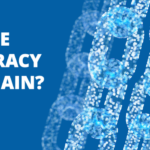Consumer Engagement: Brand Protection Strategies As A Proactive Approach
I was honoured to be invited to Chair and speak at the 6th Global Brand Protection Innovation Programme in London, 17th June 2019. Below is a transcription of my keynote presentation and the slides I presented on the day. The slide deck can be downloaded for free, and hassle-free, no need to include an email or create an account.
The Need For Brand Protection To Be Proactive
Hello – I’m going to talk about brand protection strategies as a proactive approach. This covers the previous question just asked (by an attendee to he speaker prior to my presentation. Hopefully I cover this for you, if not then you can ask questions at any point.
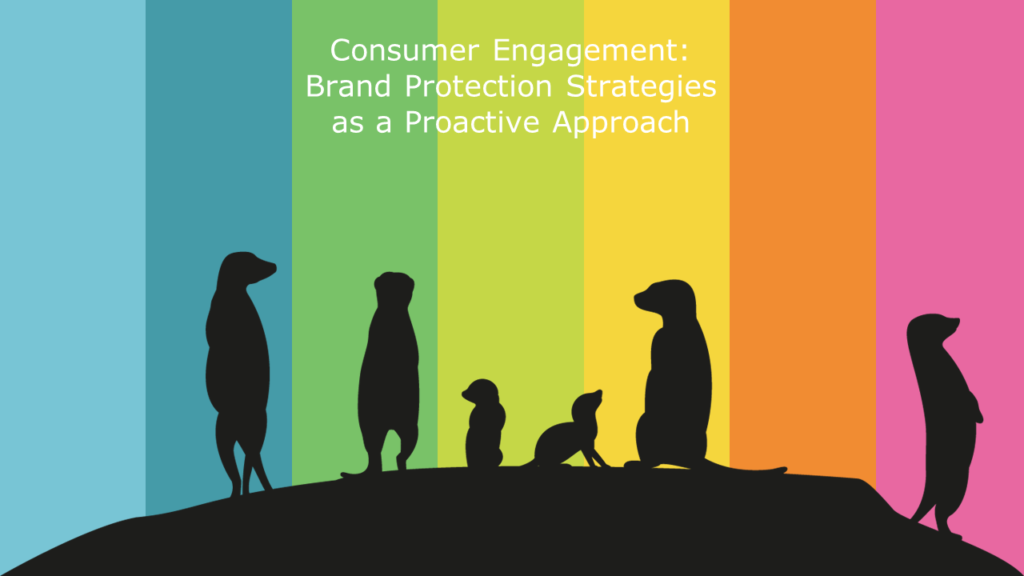
To introduce myself, my name is Steven, part of the niche brand protection consultancy – Ustels – we focus mainly on domain takedowns and social media monitoring, generally covering new trends in the space. Online brand protection is too reactionary. Brand protection is too often considered in isolation. Sometimes the issues seem so overwhelming brand protection activities go ahead of brand strategy and the work undertaken does not optimise the resources put in. Today, I’m going to talk about some trends in the main channels of communication with customers. How to use these platforms to engage customers is just as important as knowing how to remove counterfeits once detected. New channels have opened a world of opportunity for brands to connect with customers like never before. We will wrap up with some key points to consider implementing for brand owners for commercialising and protecting your intellectual property online.
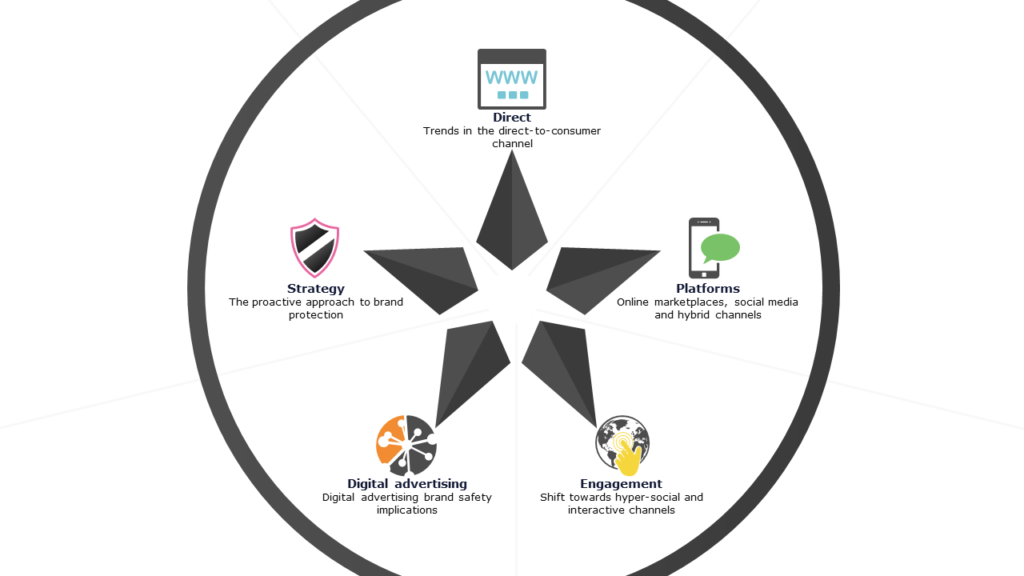
Just as a quick overall of what we are going to talk about. We are going to start with the direct channels, covering direct-to-consumer, a rapidly growing area including your own online domain names and websites, your “brand.com”, and also the offline stores and how they can be connected. The connection is where the proactive approach comes in. Then we have the online platforms, online marketplaces, social media, mobile apps etc. Then we will turn to some ways to engage customers, whether that is through your own channels or using platforms; we are going to look at some new trends in live streaming, short form video content and also Vcommerce (voice control ecommerce). Then we will touch on digital advertising, a very complicated area, but also very important for brand safety. Lastly, we will come onto strategy, outlining some steps you can take and implement into your brand protection strategy. This will include proactive steps in engaging customers and connecting the brand experiences.
Direct Channels To Engage Customers

To start with let’s look at the direct-to-consumer channel. As I said, this is one of the most rapidly growing areas for brands. Often overlook in favour of modern marketplaces and sexy social media platforms. For instance, brands often focus on brand building on Instagram or Amazon, but the direct-to-consumer market cannot be ignored. And not just the online presence, but offline stores too. One of the big retail trends now, which some brands are capitalising on is offlining. New brands will launch digital first, whether that is a parent company introducing a new brand or whether it’s a completely new brand launching. They will go online to generate a buzz before launching offline – the key is then connecting the two sides. A great example of this is Allbirds – the trendy eco trainer that got very trendy in the US. They are now offlining, and you can feel the brand when you go into their store in the Covent Garden, you can see the natural store design, which is at the core of the brand. Customers that go into the store are using it as a catalogue for the online experience. For a new trendy trainer brand, you may want to try a pair before ordering, not knowing how they fit, but once comfortable the brand the online experience may be more convenient for future purchases. In this way, the digital platform generates store visits which then generates online purchase. That keeps customers locked-in and away from illegitimate channels.
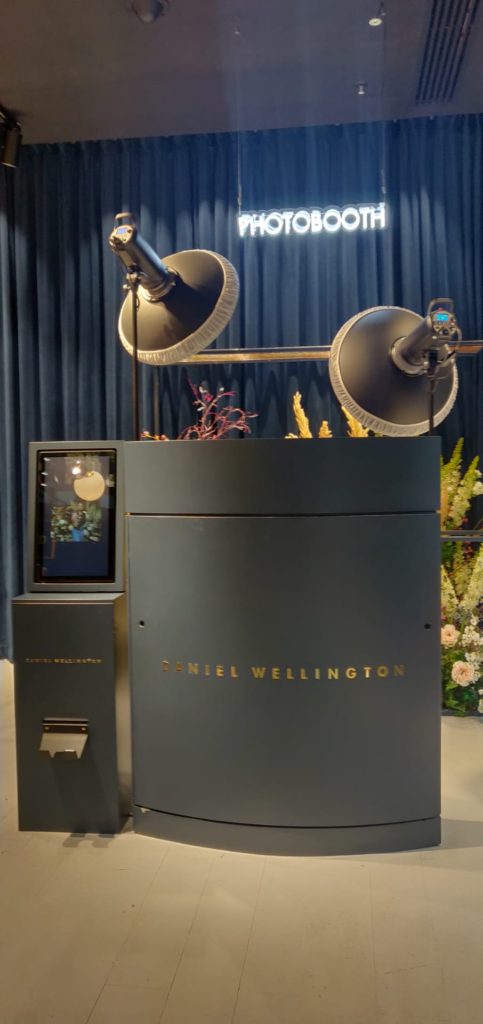
Another great example would be Daniel Wellington. They really built up their profile online, especially Instagram. Now they have offline stores and building out this channel. There is a store in Westfield for example, you go in there, the whole back section has this huge photobooth. The reason for it is to connect to their online marketing – which is all about people organically sharing images of them wearing their Daniel Wellington watch, uploading to Instagram and using the official hashtags. Customers upload so many photos of selfies whilst wearing their Daniel Wellington, it makes them feel connected to the brand and part of a community. This really connects the offline and online experience customers have when engaging with the brand. Again, this keeps customers in the channels the brand can communicate effectively using.
Next in the direct channel is domain names and websites. Traditional domain name monitoring is typically handled by monitoring newly registered domains on registries and building a strong domain name portfolio. This is vital to monitor, but no matter how big your portfolio is, a counterfeiter will always find a domain name similar that is not protected, or just purchase a cheap domain recently expired which is not related to the brand name and drive traffic through other means. This is something that requires other techniques to find infringing domains, including web intelligence and even tactics used in SEO work such as analysing backlinks and referrals can be useful. These infringing websites would not be detected via the traditional domain name monitoring process.
Dropshipping also connects to this. Using the services of Shopify or other webstore builders, an infringer can very easily make their own store. This can be done almost without cost. Most will pay small fees for the added benefits, but in less than a day a webstore can be up and running, fully customised and largely automated, using applications such as Oberlo. What this enables is for any infringer to have their own webstore, a customer goes on it, sees the address is Europe or the US and places the order thinking the webstore is trustworthy. That order actually goes directly to AliExpress, through the automation applications. The AliExpress seller ships it directly to the customer, the webstore owner never touches the product – they do relatively little. Their only goal is to drive traffic to the webstore, mainly is through digital advertising, specifically on Facebook. Customers that would normally worry about buying a fake item from AliExpress will see something pop up in their social media feed being advertised from a creditable looking webstore and are induced into purchasing. They actually purchase at an inflated price, for an item they customer would typically avoid on AliExpress! From research conducted by Ustels, using analytics on popular Shopify webstores offering for sale counterfeit items, infringers can generate revenues of seven figure sums per year. This is just infringers marketing counterfeits, importing them from China and using small packet delivery to avoid enforcement through customs.
Our approach to website enforcement is: you pay for takedowns, not notices sent. We believe this is a fair model, charging per notice creates no incentive for brand protection vendors to actually have websites taken down. Why would they call and escalate and continue to follow up when they charge per notice? As domain specialists, we charge for success – counterfeit webstores shut down and infringing content being removed.
Brand Protection On Online Marketplaces
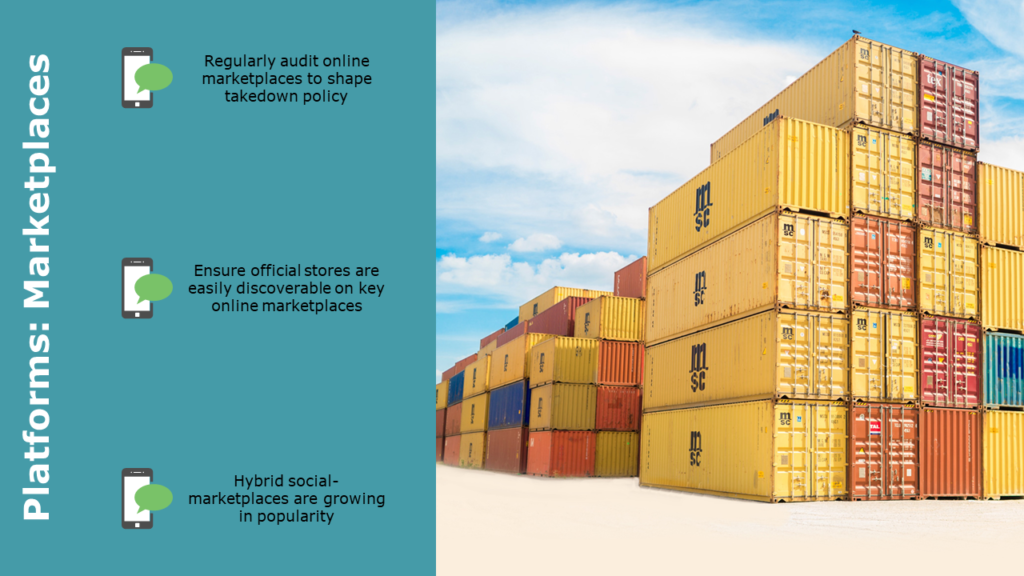
Moving on to platforms, starting with marketplaces. This topic has been covered fairly well, including the need for regular audits and risk assessments. Certain marketplaces are so big it is unlikely they will ever be removed from scope of enforcement, Amazon for example. But other marketplaces may not be important, or underestimated. The other benefit of conducting regular risk assessments, is to understand what the competition is doing. Both infringers and non-authorised sellers, there may not be any intellectual property infringement, you may not be taking anything down. But instead, looking to understand what the competition is doing and how they are being successful in diverting sales away from your official channels. With this information you can better tailor your own online store. Not only information about pricing and product description, but the adverts which are being run on the platform. Amazon is investing heavy into digital advertising and is the third largest digital advertiser in the West. This is about engaging customers already on the platform already buying products in your categories and maybe actually looking for your brand but are purchasing items from competitors. It is very important to do. Understanding the culture of the platform is vital. This point is something I will come back to as its so important.
The next point is stating the obvious – although often overlooked – is to make sure official stores are easy to stop on digital marketplaces. Amazon storefronts for example, connecting the design with the core brand so customers immediately recognise the official store.
The last point on marketplaces is about ‘hybrid marketplaces’, Depop for example. There are countless other platforms taking this approach. Marketplaces are introducing more and more social elements. Customers want the shopping experience to be fun and engaging, they want to see what their friends are purchasing, what is trending, what is receiving likes. A lot of webstores have a banner at the bottom saying ‘this item is selling fast’, these things boost sales and need to be utilised and aligned with your brand. Often app based, social marketplaces not only make shopping fun but also deliver suggestions to customers. Just searching for content, keywords or images is often not enough. For hybrid marketplaces, profiles are needed. Long gone are the days that simply writing a few scrapers is sufficient to effectively monitor digital marketplaces. Not possible. Each platform needs a deep understanding of how it works and what approach to take.
Brand Protection On Social Media

On the flip side, social media is merging with ecommerce functions, transforming into digital marketplaces in many respects. Facebook now has Facebook Marketplace and owns Instagram which has Instagram Stores. Facebook is the second largest digital advertiser, connecting Facebook, Instagram and WhatsApp into a single ecosystem, which will have its own payment method using a cryptocurrency. So from messaging to social media to ecommerce and digital payments, all integrated in a single ecosystem which has over two billion users. Details are set to be released tomorrow (Tuesday 18th June 2019). Once this is done they will be competing with the likes of Alibaba in China which has Alipay and Alibaba Cloud connecting their ecosystem. These ecosystems remove friction. That is where counterfeiters thrive, when the system has processes and logistics, it adds complexity and costs. The economics start to not add up, but a frictionless ecosystem too big for effective content governance is ideal ground for counterfeiters to flourish.
Ad spend is another factor on social media. Spending on influencers is estimated to rise to $10 billion. This can be an Instagram user, gets popular, has a following, built organically through authenticity. Brands can tap into these influencers, to benefit from their connection with their followers, KoLs in China are vital to reaching younger generations. Often times, counterfeiters use these tactics too, whereas some brands still want full control over their communication channels and so avoid. Brands must engage with customers on the customer’s terms. In a hyper fast and hyper social environment, full control is not possible. The discussion will happen, whether the brand chooses to lead it or tries hides from it.
Hyper Fast & Hyper Social
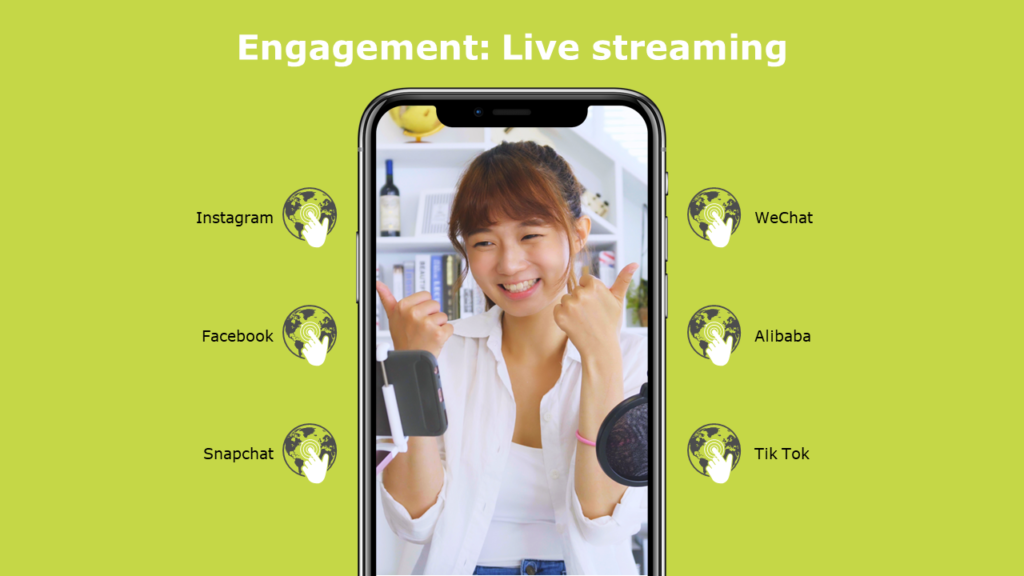
Live streaming and short form video content is one of the most interactive and engaging communication channels brands can leverage. Short form video content is Snapchat for example, you get 15 seconds to point your phone at yourself whilst recording. The quality is less important than longer form video platforms like YouTube, where viewers have high expectations for sound and video quality. Counterfeiters use short form platforms to show off their infringing wares, panning their shop or focusing on a specific item a potential customer may want to see. On Snapchat, content is not permanent, which makes reactive brand protection almost impossible. Instagram and Facebook both have live streaming features natively integrated as another strand in their ecosystem. But it is not just social media platforms, there is also Alibaba. They own Taobao, the biggest ecommerce website in the world; Taobao has live streaming integrated so sellers can stream and customers can purchase directly from the stream, using Alipay. Again, frictionless commerce, without ever leaving the grip of a single company for advertising, commerce and payments.
Alibaba spend considerable resources to build automation tools to remove counterfeits, with market leading image matching technology. Brand protection vendors also invest time and resource into enforcing infringing listings across Alibaba platforms for their clients. However, live streaming is one of the key ways sellers avoid detection on Taobao from both Alibaba’s own ‘proactive monitoring’ and brand protection vendors reactive enforcement. A traditional brand protection vendor which focuses on selling SaaS, rather than understanding branding, will see an issue, build technology to automate detection, run the automation, once data is collected it will be passed on to a person to analyse the results from a mass of data, this is to get rid of non-infringing and non-relevant content, then the data will be passed again to be actioned. Machine processing is not accurate enough for such purposes, natural language processing is not advanced enough to understand the culture and terms used during live streams. Something a human would identify immediately – the nature of the stream – is lost on a machine. By the time the traditional approach gets to enforcement there is no infringement to enforce. The sellers are agile, they will create listings with no infringing terms or images, nothing to raise suspicion or cause automated triggers for removal. This scenario is similar to digital ad campaigns ran on Instagram, promoting counterfeits. The product listing is removed after the stream boost fades, a lot earlier than any SaaS provider finally gets around to trying to enforce. Live campaigns need live enforcement.
Another platform this is an issue on is TikTok, the app is big in the West and East. See my article on World Trademark Review regarding TikTok here. The app is used in a similar way. Offline stores especially, use TikTok for digital advertising. They don’t have any other digital channels, no webstore or Taobao store for instance. They will film their store and post on the platform, the content will then be algorithmically delivered to potential customers. This is where the connection between online and offline brand protection work comes in. Understanding each channel and the intersections.

Next up we have a fascinating area – Vcommerce. As you can see from the slide, there is estimated to be 26 billion ‘internet of things’ devices by 2020. With this scale, brand owners need to get ahead of the curve in terms of marketing and brand protection. Unlike live streaming, which is happening under the nose of the brand owners who have been slow on the uptake, with brand protection vendors even slower to react. Vcommerce is an area that will hopefully be proactively shaped by brand owners to ensure they maximise the opportunity and minimise the threats. Right now, Vcommerce is not a huge risk to be honest, however, it is growing and how it gets rolled out will be determined, right now, just by the big platforms – Amazon and Google. Both have been accused of using their market dominant positions to favour their own products and services over rivals. Can brand owners afford to let these companies completely dictate the market? Both have shown willingness to work with brand owners and engage in productive conversations to resolve issues. Working together to create opportunities in this space is so important. Tools area already available for brand building, but not being used enough, how many brand owners have their own Alexa Skill?
Brand Safety Requires Oversight
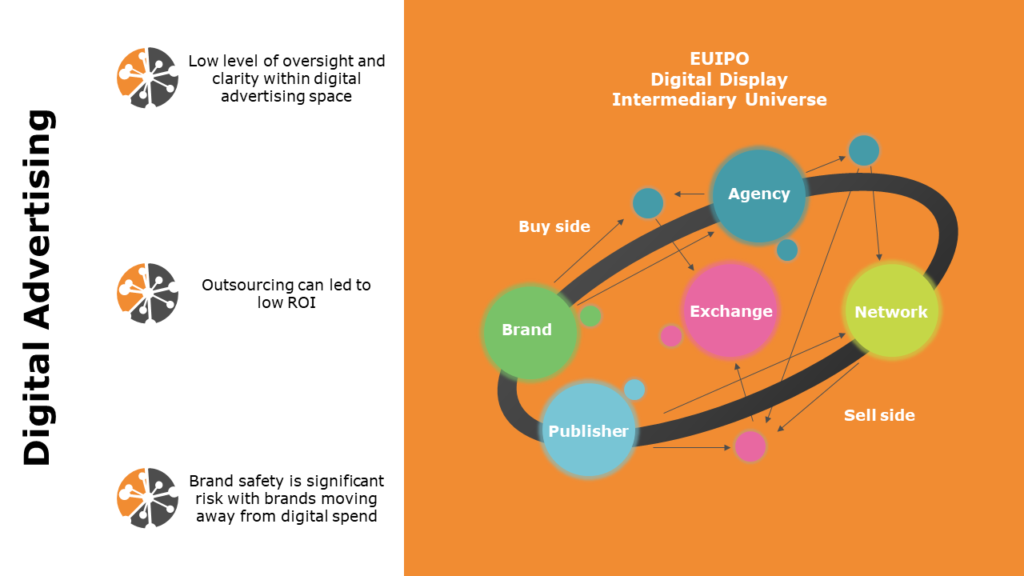
My last area before turning to the takeaways – digital advertising. This graphic (above) is adapted from the EUIPO report looking at brand safety in digital environments. As you can tell, it is hugely complicated area to measure, but what was found is it presents a significant risk to brand safety. There have been many examples of household brands having their adverts appear next to content they would not wish to be associated with, for example, having their ad roll before a YouTube video promoting terrorist organisations. There are very low levels of oversight as its so complicated. Brand owners are now deciding ‘I don’t want to deal with this’ so outsource the process completely. Which is a very bad idea in both digital advertising and brand protection generally. Giving away a communication channel in this way creates a barrier between the brand and customers. But more than that, brand safety is not something that you can give away responsibility to a third party. Brands are now openly saying they will not spend as much on YouTube and going back to more traditional channels. This needs to be an internal decision which is best for the brand and marketing, rather than decided out of fear or lack of oversight over digital ad spent. Brands should maintain oversight over the campaigns and hold providers and publishers account for brand safety issues, to maximise the channel. If the ads are not reaching the right people, the right demographic then the campaign is not worth the money spent.
Brand Protection Strategy

Brand Protection+
The last slide! Strategy. I have called it strategy, but it is obviously not strategy, as this would need to be worked out individually for a brand in combination with marketing, brand managers, legal and security and others, and then be far more comprehensive than a single table. It can’t just be brand protection in isolation. It never works that way. It needs to be connected and wrapped around your core brand strategy. That is the most important point.
Website Takedowns
On to some of the takeaways. Domain monitoring is very important as I said before, hundreds, thousands of webstores selling counterfeits and abusing brand assets. You need a way of monitoring and an affordable way to enforce. The economics are fantastic for infringers at the moment, the cost of enforcement is significantly higher than the cost of a counterfeiter setting up shop, it is so mis-aligned, this creates the space for counterfeiters to step into. This channel needs to be cut off.
Connected Customer Experience
Next up, connecting the online and offline brand experience. Look at the Allbirds and Daniel Wellington examples, this allows them to capture customers in official distribution channels to maximise potential sales.
Assessing Online Marketplaces
Monitoring key marketplaces, we talked about risk assessments and the importance of understanding the culture of each platform, with actual reasons to enforce on each marketplace enforcement work is being undertaken on. Money spent enforcing the wrong marketplaces is hugely expensive for brand owners.
Engaging On Social Media
Social media, you need to develop a strong brand voice on social media. It is not enough to have a page full of bulletins and updates. If it is a platform that you want to be on, then you need to invest in it and engage with customers how they want to be engaged. People don’t use Twitter the same way they use Instagram or Facebook etc. The platforms are not the same and should not be approached in the same way. Repeated content is boring, don’t repeat the same content on all social media channels. The internet is hyper fast and hyper social, potential customers will find more engaging content elsewhere, including channels which abuse your brand and IP. Another key point on social media is about providing customer service, it’s a real growing area. Therefore, social media managers must be trained in handling intellectual property infringement cases, including customers who have been deceived into purchasing a counterfeit. The first place they go to is often social media – mainly because most websites do not have telephone numbers and use chatbots. This helps brands quickly identify IP issues and take swift action before other customers see the infringements. Social media managers should be one of the first responders to counterfeit issues and trained in bringing the potential customer back into desired channels of engagement.
Engage To Protect
The next point is about using new channels to engage customers and keep them out of non-authorised or illicit channels. We spoke about live streaming, short form video content and Vcommerce. These forms are very interactive, engaging and in demand.
In-Housing
Lastly, in-housing. Whilst it is my job to sell brand protection services, consider in-housing, at least partially. For oversight and understanding of internal culture, internal resource dedicated to brand protection is vital. For small brands, training staff which may come across IP issues helps to bridge the gap if dedicated brand protection resource is too expensive. Social media managers are one great example.
I hope that helped bridge the gap between marketing and brand protection for consumer engagement when considering new platforms and trends to shape your digital IP strategy.


